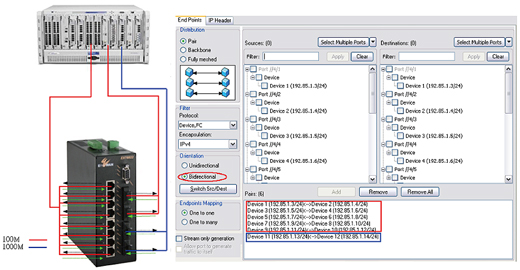How to Choose a Suitable Ethernet Switch for IP Surveillance ? (Part 1 of 2)
■ How does it work?
When making a purchasing decision for networking equipment there are many factors that must be taken into account. The following article will give some of the information you need to help make an informed decision, protecting your equipment investment and enabling a reliable network. This article uses an IP surveillance application as an example but the information provided can be used for just about any Ethernet network application.
As IP surveillance systems become more popular, an increasing number of new projects are now completely IP based. To choose a suitable Ethernet switch many variables must be taken into consideration such as; switch performance, bandwidth, and PoE power capability among others. To keep this article a reasonable size we will examine the switch performance and bandwidth aspects this month and the PoE requirements next month.
Ideally, all available image monitoring, motion tracking, PTZ, and data storage bandwidth requirements are assessed in the planning stage of a project to insure that the most optimal system is put in place. Unfortunately, this is not always the case and systems are put into place without determining the bandwidth required for the system to function properly. We will examine two common terms used in describing switching products that are often misunderstood; Non-Blocking and Full Wire-Speed. Understanding how these affect the performance and reliability of a network is important for proper network design.
Non-blocking, and full wire-speed both refer to the performance capability of the Ethernet switch. For example, with a 24 port 10/100/1000 gigabit switch, if each port is 2Gbps in full duplex mode, then 24 ports means the device has a theoretical maximum of 48Gbps. When this volume of data is passed through the switch without interruption, the switch performance can be categorized as non-blocking or wire-speed. If the switch is connected to another switch, that is not full wire-speed or blocking, network problems may occur. In an IP Surveillance application, if the switch is connected to a server for video processing and to NAS or SAN storage for video storage, then non-blocking and full wire-speed is essential to minimize any potential data loss from bursting video transmission and to ensure smooth video replay. Users can only rely on the data provided by the vendor to know if the desired switch will provide the performance needed for their application. Otherwise, a user must test the switch's capability using expensive testing equipment, such as Spirent SmartBits TestCenter, which is unlikely. It is often not possible to derive the switch's capability from the product specification or datasheet, the key items to look for are; switch capacity, full wire-speed and bandwidth capacity.
Using a Spirent SmartBits TestCenter to test EtherWAN's EX78822 switch with 8 10/100 RJ45 ports, 2 10/100 fiber ports and 2 GB fiber ports we can see how the below report shows that it is "full wire-speed."

■ Figure 1
All of the cables are connected and data transfers set up between all 8 pairs of RJ45 10/100 ports , plus the 2 10/100 fiber ports, and the 2 GB fiber ports.

■ Figure 2
It is important to understand that you should not expect to operate any network switch equipment at their full capacity over an extended period of time. Not only is this poor planning and unrealistic, it places significant stress on the equipment and directly impacts network stability. In an actual application, once the equipment performance has been fully understood, appropriate performance adjustments must be made to ensure a reliable network that accounts for unforeseen traffic bursts. These adjustments should include network device management, traffic flow and load monitoring to keep the network optimized. It is a good design practice for the switch equipment to have spare capacity to allow for expansion and avoid sudden changes in the network environment that could affect overall network performance.
At EtherWAN we stand behind our products with rigorous testing ensuring our products meet the performance and reliability needs of our customers and will gladly assist you in proper switch selection and network design for your next application. Tune in next month to understand the PoE requirements for an IP Surveillance application.
■ About EtherWAN
EtherWAN Systems, founded in 1996 in Irvine CA, has become a leader in Ethernet connectivity for critical applications in various markets including IP Surveillance, Intelligent Transportation Systems (ITS), Renewable Energy, Smart Grid, Utility, Oil & Mining, Factory Automation, etc. EtherWAN specializes in designing and manufacturing fiber optic Ethernet products and Ethernet equipment for harsh environments. The available products are hardened Ethernet over VDSL equipments, hardened media converters from serial/Ethernet to fiber or wireless, PoE switches, IEC61850 based hardened Ethernet equipments for power distribution and substation applications, EN50121-4 & EN50155 based products for railway and train networking applications, and those for UL1604 based hazardous locations. EtherWAN's US headquarters are located in California USA with Pacific Rim headquarters and manufacturing facility in Taipei, Taiwan. With engineering expertise at both sides of the Pacific Ocean and its own production lines in Taiwan, EtherWAN continues to serve the markets with advanced Ethernet products at affordable prices.





